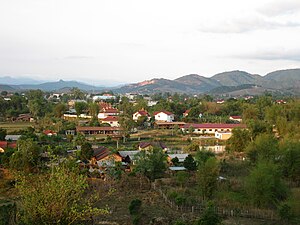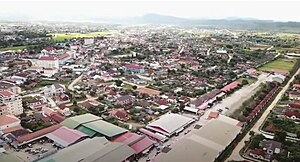Phonsavan
19°28′N103°11′E/ 19.46°N 103.18°E
Phonsavan
ໂພນສະຫວັນ | |
|---|---|
| Pek District | |
 Phonsavan | |
| Coordinates:19°25′N103°10′E/ 19.417°N 103.167°E | |
| Country | |
| Admin. division | Xiangkhouang Province |
| Elevation | 3,600 ft (1,100 m) |
| Population (2015)[1] | |
| • Total | 75,600 |
| • Religions | Buddhism |
| Time zone | UTC+7(ICT) |
| Area code | 061 |
| Climate | Cwa |
Phonsavan(also spelledPhonesavanh,Lao:ໂພນສະຫວັນ,pronounced[pʰóːnsā.wǎn]), population 37,507, is the capital ofXiangkhouang Province.[2]Phonsavan was built in the late-1970s and replaced old Xiang Khouang (today known asMuang Khoune), which was destroyed during theSecond Indochina War.
Phonsavan is known for the nearbyPlain of Jars,a UNESCOWorld Heritage Site.[3]The main economic activities in Phonsavan are based on governmental administration, mining by Chinese and Australian companies, tourism, and the work ofnon-governmental organizationsclearingunexploded ordnance(UXO).
History
[edit]
While the origin of the Plain of Jars people is unknown, the recorded history of Xiangkhouang is interlinked with theTai Phuan.The Tai Phuan or Phuan people are a Buddhist Tai-Lao ethnic group that migrated to Laos from southernChinaand by the 13th century had formed the independent principality ofMuang Phuanat the Plain of Jars, with Xiangkhouang (contemporary Muang Khoun) as the capital. They prospered from the overland trade in metals and forest products. In the mid-14th century, Muang Phuan was incorporated into theLan Xangkingdom under KingFa Ngum.
The Phuan population were able to retain a high degree of autonomy, although they had to pay tax and tribute to Lan Xang. During the 16th century expressiveBuddhist artand architecture flourished. The capital was dotted with temples in a distinct Xiangkhouang style, with simple low roofs and a characteristic "waist" at the foundation. In 1930, Le Boulanger described it as "a large and beautiful city, protected by wide moats and forts occupying the surrounding hills; and the opulence of the sixty-two pagodas and their stupas, of which the flanks concealed treasures, obtained the capital a fame that spread fear wide and far."
After theKingdom of Siam(contemporaryThailand) extended control to Laotian territories east of theMekongin the 1770s, Muang Phuan became a Siamese vassal state and also maintained tributary relations withĐại Việt(contemporaryVietnam). To exert greater control of the lands and people of Muang Phuan, the Siamese launched three separate campaigns (1777–1779, 1834–1836, and 1875–1876) to resettle large parts of the Phuan population to the south into regions under firm Siamese control. Subsequentinvasions by Haw maraudersand splinter groups of ex-Taiping Rebellionrevolutionaries from southern China plundered Luang Prabang and Xiangkhouang in the 1870s, and desecrated and destroyed the temples of the Phuan region.
The Franco-Siamese treaties of the 1890s placed Xiangkhouang under colonial rule as part ofFrench Indochinauntil shortly afterWorld War II.The French used Xiangkhouang as their provincial capital. A few ruined colonial public buildings remain, such as the governor's residence, church, and the French school.[4][5]
During theLaotian Civil War,Xiangkhouang was the scene of extensive ground battles and intense aerial bombardment due to its strategic importance.HouaphanhandXiangkhouangprovinces were strongholds ofPathet Laoforces and theirNorth Vietnameseallies. Thecovert air campaignconducted by theUnited States Air Force,either to neutralize communist forces or to drop unused ordnance after returning from missions in Vietnam, turned Laos into the most heavily-bombed nation in world history.
Phonsavan was built after the fighting ended in 1975 to replace the former provincial capital,Muang Khoun(old Xiang Khouang), which was destroyed by wartime bombing and only partially rebuilt since.[6]
-
Jars, Ban Phakeo
-
Jar Site 3
-
Ruins,Wat Phia Wat(16th century)
Climate
[edit]Phonsavan hashumid subtropical climate(KöppenCwa) tempered by its high elevation (1,100 m). The city has long, warm, wet summers and short, dry winters. Average June temperature is 23.6 °C, average December (the coldest month) temperature is 14.8 °C.
| Climate data for Phonsavan, elevation 1,094 m (3,589 ft), (1996–2005) | |||||||||||||
|---|---|---|---|---|---|---|---|---|---|---|---|---|---|
| Month | Jan | Feb | Mar | Apr | May | Jun | Jul | Aug | Sep | Oct | Nov | Dec | Year |
| Record high °C (°F) | 30.3 (86.5) |
32.2 (90.0) |
33.2 (91.8) |
35.0 (95.0) |
34.4 (93.9) |
34.3 (93.7) |
32.4 (90.3) |
32.1 (89.8) |
32.4 (90.3) |
32.0 (89.6) |
32.8 (91.0) |
30.0 (86.0) |
35.0 (95.0) |
| Mean daily maximum °C (°F) | 23.3 (73.9) |
25.7 (78.3) |
28.1 (82.6) |
28.7 (83.7) |
27.1 (80.8) |
27.2 (81.0) |
26.7 (80.1) |
26.5 (79.7) |
26.6 (79.9) |
25.4 (77.7) |
23.8 (74.8) |
21.7 (71.1) |
25.9 (78.6) |
| Mean daily minimum °C (°F) | 8.8 (47.8) |
10.7 (51.3) |
14.0 (57.2) |
16.6 (61.9) |
19.0 (66.2) |
20.0 (68.0) |
19.7 (67.5) |
19.4 (66.9) |
17.8 (64.0) |
15.4 (59.7) |
11.6 (52.9) |
7.8 (46.0) |
15.1 (59.1) |
| Record low °C (°F) | −2.2 (28.0) |
1.7 (35.1) |
3.1 (37.6) |
7.3 (45.1) |
11.1 (52.0) |
13.7 (56.7) |
16.1 (61.0) |
15.1 (59.2) |
9.8 (49.6) |
2.6 (36.7) |
0.6 (33.1) |
−1.0 (30.2) |
−2.2 (28.0) |
| Averageprecipitationmm (inches) | 8.7 (0.34) |
15.8 (0.62) |
56.9 (2.24) |
145.2 (5.72) |
193.6 (7.62) |
193.0 (7.60) |
276.8 (10.90) |
300.9 (11.85) |
158.2 (6.23) |
63.6 (2.50) |
23.1 (0.91) |
8.4 (0.33) |
1,444.2 (56.86) |
| Average rainy days | 2 | 3 | 5 | 13 | 18 | 20 | 22 | 22 | 16 | 9 | 4 | 2 | 136 |
| Source 1: World Meteorological Organization[7] | |||||||||||||
| Source 2:NOAA(extremes),[8]The Yearbook of Indochina (1932-1940)[9][10][11][12][13] | |||||||||||||
See also
[edit]References
[edit]- ^"Results of Population and Housing Census 2015"(PDF).Lao Statistics Bureau.Retrieved19 February2024.
- ^"Laos Population".Worldometer.Retrieved17 May2020.
- ^"Megalithic Jar Sites in Xiengkhuang – Plain of Jars".UNESCO World Heritage Centre.UN.Retrieved16 May2020.
- ^Provincial Tourism Department Xiangkhouang, A Guide to Xieng Khouang
- ^Stuart-Fox, Martin (1998).The Lao Kingdom of Lān Xāng: Rise and Decline.White Lotus Press.ISBN978-974-8434-33-9.
- ^Ciochon, Russell L. (15 June 2009)."Laos Plain of Jars in the Wake of American Bombing".The Asia-Pacific Journal.24-3-09.Retrieved16 May2020.
- ^ "World Weather Information Service - Xiengkhuang".World Meteorological Organization.Retrieved10 June2012.
- ^"Global Surface Summary of the Day - GSOD".National Oceanic and Atmospheric Administration.Retrieved26 January2023.
- ^The Yearbook of Indochina (1932-1933)
- ^The Yearbook of Indochina (1934-1936)
- ^The Yearbook of Indochina (1936-1937)
- ^The Yearbook of Indochina (1937-1938)
- ^The Yearbook of Indochina (1939-1940)
External links
[edit] Media related toPhonsavanat Wikimedia Commons
Media related toPhonsavanat Wikimedia Commons Phonsavantravel guide from Wikivoyage
Phonsavantravel guide from Wikivoyage- Eco-tourism Laos




